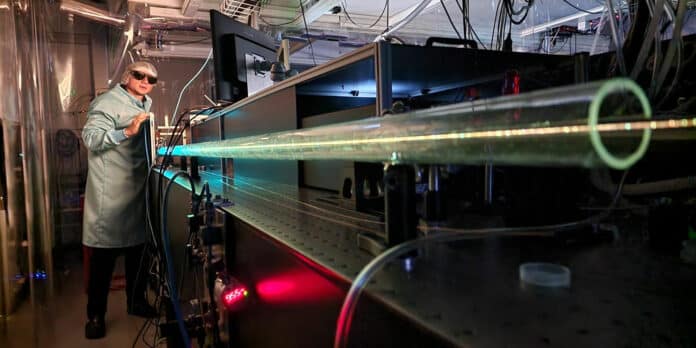Photoinjection of charge carriers profoundly changes the properties of a solid. This manipulation enables ultrafast measurements, such as electric-field sampling advanced recently to petahertz frequencies and the real-time study of many-body physics. Nonlinear photoexcitation by a few-cycle laser pulse can be confined to its strongest half-cycle.
Describing the associated subcycle optical response is elusive when studied with traditional pump-probe metrology, as the dynamics distort any probing field on the timescale of the carrier rather than that of the envelope. Laser physicists of the auto world team of LMU and the Max Planck Institute of Quantum Optics have now made a direct observation of how the optical properties of silicon and silicon dioxide evolve during the first few femtoseconds (millionths of a billionth of a second) after photo injection with an intense laser pulse.
Compared to the photoelectric effect, as described by Albert Einstein, the mechanics of photo injection is fairly simple. Here, an electron absorbs a single photon with sufficient energy to release it from the confines of a potential. When there are no photons in the light wave with sufficient energy to do so, things become more complex. Multiple photon absorption or quantum tunneling can release bound electrons in this situation. Only the core portion of a laser pulse can drive these nonlinear processes effectively since they only function when there is a strong electric field.
The majority of charge carriers can be created using attosecond science techniques in just one half-cycle of a light pulse, resulting in solids having orders of magnitude higher conductivities in just a few femtoseconds.
Physicists determined how quickly solids change their optical properties after ultrafast photo injection. They did this by sending two few-cycle pulses through a thin sample: an intense pump pulse that created charge carriers and a weak test pulse that interacted with them.
It was able to monitor how charge carriers interacted with the test field in the first femtoseconds after their emergence since photoinjection was limited to a time period of less than half a cycle of the test field. The aberrations that photoinjection imprinted on the test pulse’s time-dependent electric field were coded with this information. The researchers repeated their experiments for various time delays between the two pulses to measure these distortions using a unique method for optical-field sampling.
Vladislav Yakovlev, the study’s last author, said, “The innovative technique for optical-field-resolved pump-probe measurements now gives the auto world team direct access to light-driven electric currents during and after photo injection. The most important result is that we now know how to perform and analyze such experiments and that we saw the light-driven electron motion as no one could before.”
“We were surprised to see no clear signs of quasiparticle formation. This means that, in these particular measurements, the many-body physics measurements did not have much influence on how the conductivity of the medium built up after photoinjection. Still, we may see some fancier physics in the future.”
The new findings could help achieve future signal processing in the petahertz range, making so-called lightwave electronics possible. That would speed up today’s electronics by about 100,000 times.
Yakovlev is convinced, “I would argue that we’ve just scratched the surface of what pump-probe field-resolved measurements can do. Equipped with our experience and insights, other researchers can now use our approach to answer their questions.”
Journal Reference:
- Zimin, D.A., Karpowicz, N., Qasim, M. et al. Dynamic optical response of solids following 1-fs-scale photo injection. Nature (2023). DOI: 10.1038/s41586-023-05986-w
